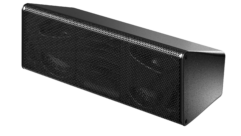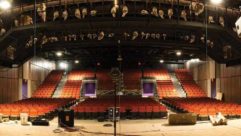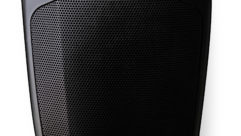
Directional Bass Using Omnidirectional Components
Sep 21, 2004 7:09 PM,
By Bob McCarthy
Four element deep line source in a reverberant environment.
There are additional ways to achieve cardioid response using your existing omnidirectional subwoofers. Independent of model or make, the key factors depend instead on the length of the overall array, spacing between the elements, and phase alignment.
With a full-range system, the combined directional pattern of multiple units is hugely dependent upon relative placement. It is critical to minimize speaker spacing in order to reduce the phase cancellation due to multiple sources. Displacement of half an inch is enough to cancel at 8 kHz, so small offsets really matter. The name of the game is to make the array as close as possible to the theoretical ideal of all sound coming from a single point in space.
Fig 1: Subwoofers packed tightly at 40 Hz (top) and 80 Hz (bottom).

The same is true for low frequencies, but different techniques must be applied to achieve similar results. With subwoofers, making it resemble a perfect point is easy because it takes feet of displacement before things begin to cancel. But a perfect point source subwoofer is omnidirectional, which is exactly what you don’t want. Directional control is achieved by spreading the array elements apart and introducing phase shift between the elements to steer the pattern in the desired direction. The more elements you have and the more they are spread apart, the tighter the pattern—within limits.
Fig 2: Subwoofers spread to 2 meters at 40 Hz (top) and 80 Hz (bottom). Note the improved horizontal control over the tightly packed speakers in Fig. 1 and the lack of rear rejection.

The spacing is limited to two thirds of the wavelength of the highest frequency. In the case of subwoofers, this would be approximately 110 Hz, leaving you with a maximum spacing of 2 meters (about 7 feet). With spacing greater than two thirds of the wavelength, the pattern becomes irregular because of phase cancellations. But for frequencies below that, the pattern exhibits control on that geometric plane. For example, a series of subwoofers, spaced horizontally, will show increased control over a tightly packed block of the same units. A vertically spaced array of subwoofers, though a considerable logistical challenge, would collapse the vertical pattern in a similar fashion. These arrays, while squeezing the pattern in one plane, do nothing to increase the ratio of energy from front to back, creating a bidirectional or figure-8 type pattern rather than the cardioid pattern that is desired. In order to achieve front to back control, a more advanced method must be employed.
Fig 3: Single subwoofer response at 40 Hz (A) and 80 Hz (B). Note nearly omnidirectional pattern.

Taking the spaced line source theory to the next level, you now place the speakers in a four-element line, front to back, facing toward the audience. Each element has independent signal feeds. In this case, the front elements would arrive earlier than the rear elements. Without additional signal processing, such an array would cause multiple arrivals in the listening area. However, the advent of modern low-cost signal processing allows you to economically provide phase manipulation for forward steering of the array. That is done by sequentially delaying each of the forward elements to be in time with the rearmost element. The result is a four-element array that is in phase in the forward direction and out of phase going backward. In the forward direction, the addition is nearly perfect on-axis to the array, becoming less perfect as you move to the sides. At the sides, the displacement of the speakers is not perfectly compensated by the time delay. The result is a different degree of phase shift at each frequency, with higher frequencies narrowing more quickly than low frequencies. At the rear, by contrast, the elements all arrive at different times at all locations. That results in substantial cancellation at the frequencies and locations where the arrivals are around 180 degrees out of phase. In the best-case scenario, a four-element array can achieve approximately 10 dB of reduction over a two-octave span.
Fig 4: Two subwoofers in line without delay at 40 Hz (A) and 80 Hz (B). Note lack of forward steering.

Now I’ll explore how this cardioid steering technique works. I will begin with two elements one meter apart. At the front of the array, the second speaker arrives 2.94 ms late. From behind the array, the inverse relationship occurs. In both cases, this out-of-time arrival would create additions at some frequencies and subtractions at others, depending upon the relative phase of the arrivals. At 170 Hz, the combination would cancel (180 degrees). At 85 Hz, there would be 3 dB of addition (90 degrees). There is obviously no benefit to this because the same thing is happening both front and back. Now I’ll delay the forward speaker 2.94 ms to synchronize it in the front. All frequencies in the front now arrive at the same time and combine to result in an addition of 6 dB. At the rear, however, the speakers are out of time by 5.88 ms because of the combination of both physical displacement and electronic delay. This results in deep cancellation at 90 Hz (180 degrees) and in lesser amounts of cancellation above and below that. This effect is limited to approximately half an octave; however, additional elements can extend the affected frequency range. The third row is placed 2 meters ahead and delayed 5.88 ms. Again forward addition is perfect, but in the rear, the systems cancel at 42 Hz. Adding the fourth elements extends the cancellation zone down to 28 Hz.
Fig 5: Two subwoofers in line with delay at 40 Hz (A) and 80 Hz (B). Note that forward steering is effective at the higher frequency.

The cardioid array constructed from omnidirectional elements has the advantage of higher efficiency: for example, all drivers are forward facing and combining in phase in the listening area. This technique can be effective, provided that close attention is paid to the details. Speakers must be placed with great care, and the delay times must be set with a high degree of accuracy. If there are mispatches, the delay settings will be sent to the wrong speakers and the steering will be completely unpredictable and could go anywhere. One thing is certain; no energy is lost, so you had better be certain it goes in the forward direction. The two techniques described here—horizontal spacing and the four-element deep line source—can be combined into an array that resembles a graveyard in appearance. Together these provide horizontal control and forward steering. The downside of this is the challenge you will face logistically.
The author wishes to acknowledge the assistance of Mauricio Ramirez for sharing his field experience using these techniques.










